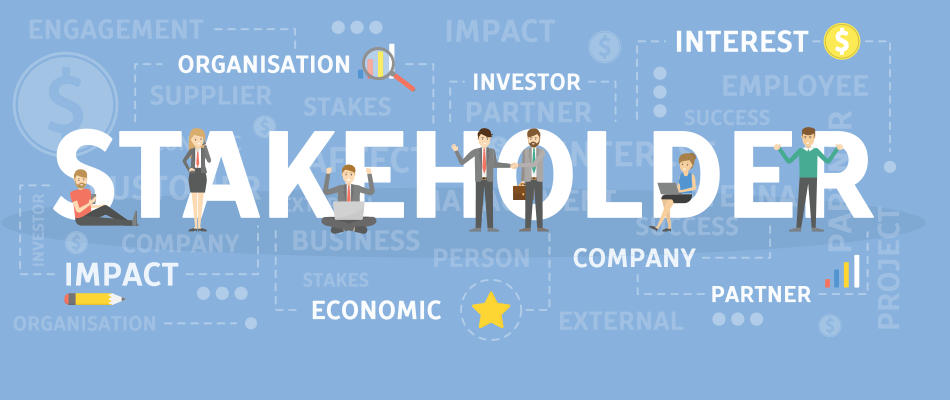The Regenesys Business School’s innovative and cutting edge curriculum in it’s International Leadership Development Programme introduces participants to the vital area of corporate governance within the world of the ‘new normal’. These include issues such as stakeholder Engagement. But what do we mean by the term, exactly?
Stakeholder engagement can seem like such a waste of time to the Executive Office. Lots of talking, no demonstrable increase in value or revenue, and it’s all about the touchy, feely stuff. Right? Wrong. Incredibly wrong.
This is how you can go about making sure the members of your C-Suite, and in particular your CEO, understands the value that Stakeholder Engagement can and will deliver to your organisation.
What is stakeholder engagement?
Firstly, we need to create a clear distinction between customer relationship management, public affairs, public participation and marketing on the one hand and stakeholder engagement on the other. The other disciplines are important and will support the stakeholder engagement agenda, but they are not synonyms for stakeholder engagement. They have a different approach and a different lifecycle, with different outcomes. Your role at meetings and in conversations is to correct that confusion. According to the Association for Project Management, ‘Stakeholder engagement is the systematic identification, analysis, planning and implementation of actions designed to influence stakeholders.’
The Line of Sight
The CEO stakeholder engagement Line of Sight is helpful in presenting the stakeholder world to your CEO. We will examine it below.
 Stakeholder Engagement Strategy
Stakeholder Engagement Strategy
The Strategy
The first thing is to demonstrate how the stakeholder engagement strategy will support the Corporate Business Strategy. Marketing has a marketing strategy, Manufacturing has a manufacturing strategy. Your stakeholder engagement strategy must be tightly linked to the Corporate Strategy. Spell it out. If you see a stakeholder engagement document that starts off with a detailed description of Government departments, you know that they have lost the plot. You work for your employer, not for government.
The Issues
Your CEO wants to see a detailed analysis of the issues facing the organisation. These must be in sufficient detail so that he or she can understand how it is viewed from both sides, and what the successful outcomes will look like. Four bullet points on a PowerPoint presentation do not constitute a detailed issues analysis. This is really hard to do, so your early attempts will not be perfect. Keep at it!
In summary, your CEO wants to know what issues are going to negatively affect the business, [make it lose money!] and it’s good if you have some positive issues in there as well. The issues must be prioritised and presented in such a fashion so that the relative significance of each can be evaluated. A list of 20 issues in bullet point form has no value at all. As the saying goes, your stakeholders won’t put you out of business, but their issues will! So make sure your CEO understands the issues and has assimilated the interpretation of those issues.
The Stakeholders
Then your CEO wants to see where these issues reside. Which stakeholders have what issues? Are similar issues spread across a number of stakeholders? Are critical issues concentrated in a small number of stakeholders? Here too a systematic stakeholder analysis is required. What is the history of the relationship? What is the desired outcome of engagement? Does the stakeholder want to engage? The relationship between stakeholders should be presented in such a fashion so that the relative significance of each can be evaluated. This is the realm of the frequently misunderstood stakeholder map. You role is to make your CEO comfortable with the content and interpretation of the stakeholder map.
Engagement Behaviours
So now your CEO understands what stakeholder engagement is, what the issues are and who the stakeholders are. What now? You need to describe the engagement behaviours. You need to demonstrate who in the organisation is going to engage with which stakeholder and how they are going to go about it? A list of meetings is no good. Sometimes you will negotiate, sometimes you will merely inform, other times you will set up a joint project team, and other times there will be shared governance structures. It has to tie back to the stakeholder, the issue to be addressed, and the desired outcome. [Note the Outcome is not the same as the Output!] Matters such as tone of voice, attitude and body language play a part. Now an aside: The King IV Code is a remarkable contribution. It lays emphasis on the quality of stakeholder relationships, and this is a very good thing. Unfortunately many practitioners have taken this to mean that all relationships with stakeholders must be warm and harmonious, and that there is one set of standard criteria to evaluate the quality of all stakeholder relationships. The real world is not like this. The qualitative dimensions of a ‘good’ relationship with a regulator is very different to a ‘good’ relationship with a militant social media community. Your role is to interpret all this to the CEO and provide discrete and constructive feedback.
Support and Implementation
Now your CEO has a strong appreciation of the domain of your stakeholder engagement strategy. But you need to have the support and implementation mechanisms in place. This includes Gantt charts and action plans, performance contracts and reports, communication plans and impact reviews. You need to show your CEO that you have these under control. Budgets must be costed. Stakeholder-facing staff must have suitable performance goals and targets. Regular reports must go to the board and EXCO; and then there’s the Annual Integrated Report. Don’t forget training; issues and stakeholder analysis are a unique skills set. Incorporate risk management, this is how you co-opt the CFO! All this forms the minutiae of successful operations management. Master it, do it well. It will bolster your personal credibility. If your budget is skimpy, emphasise the issues and the related risks. Demonstrate how your budget and actions will mitigate those risks. Confront your CEO with some reality testing: if we don’t manage this issue well, the following downside will result. If the answer still is no, you will have the privilege of saying “I told you so’ later on.
Put these actions together within a systematic organisation-aligned strategy, and over time you will reap the benefits of a structured stakeholder engagement plan.
The International Leadership Development Programme (ILDP) from Regenesys Business School comprises of a world-class, innovative and disruptive curriculum that develops leadership competencies for the new digital world, and included an in depth-focus on issues around corporate governance, such as Stakeholder Engagement.
The intense programme explores cutting-edge knowledge, global trends and best practice in digital transformation, entrepreneurship, strategy, and innovation from the fastest-growing companies in the USA.
Participants are exposed to applied learning using innovative learning techniques, master classes, exposure to giants of industry, focused networking opportunities and commercial
matching to sector-level opportunities. The programme is facilitated by global faculty comprising experts in specialised fields as well as top business leaders.






